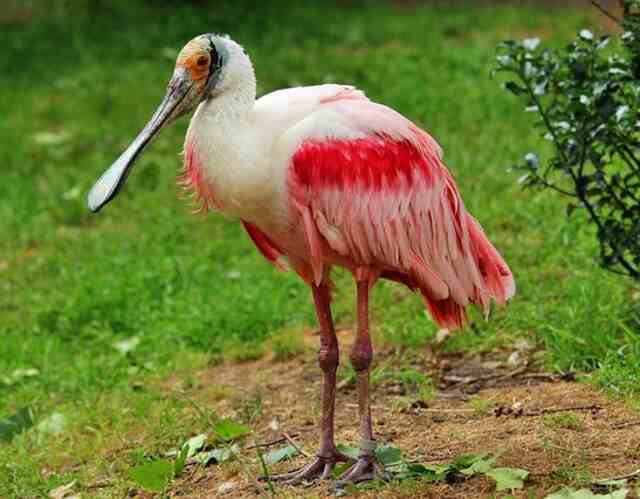Bird beaks are specialized structures that have evolved to help birds perform a variety of tasks such as feeding, grooming, and even singing. Beak shapes and sizes vary widely among bird species and are adapted to the specific needs of the bird’s lifestyle, environment, and diet.
One type of beak is the flat beak, which is characterized by its flattened shape that is useful for sifting through shallow water or mud in search of food. In this article, we will take a closer look at seven spectacular birds with flat beaks and explore their unique adaptations and behaviors.
Table of Contents [show]
Types of Birds with Flat Beaks
Roseate Spoonbill
The Roseate spoonbill is a wading bird with a unique flattened bill that is shaped like a spoon or spatula. This bill is broad and flat, with a slightly curved tip that resembles a teaspoon. The Roseate spoonbill’s beak is designed to help it feed on aquatic creatures such as fish, crustaceans, and mollusks that live in shallow water or mud.
The Roseate spoonbill’s bill is used to scoop up prey from the water, and it is equipped with specialized sensory receptors that can detect vibrations in the water, enabling the bird to detect movement and locate its prey. The flattened shape of the beak also allows the spoonbill to filter out mud and debris from the water, leaving only food behind.
In addition to its feeding adaptations, the Roseate spoonbill’s beak is also used in courtship displays and social interactions with other birds. During courtship, male spoonbills will often use their beaks to sweep the water surface in an elaborate display to attract mates. The Roseate spoonbill’s beak also plays a role in thermoregulation, as it helps the bird dissipate heat in warm environments by exposing a large surface area to the air.
Shoebill
The shoebill (Balaeniceps rex) is a large bird native to East Africa with a unique and impressive flat beak. The beak of the shoebill is long and wide, measuring up to 24 cm in length, and shaped like a shoe, hence the bird’s name. The beak is covered in sharp edges and hooked tips, making it an effective tool for catching and grasping prey.
The shoebill’s flat beak is perfectly adapted for its unique feeding habits. The bird is known to stand motionless for hours in swamps, waiting for fish to swim by. When a suitable prey is detected, the shoebill strikes with remarkable speed and accuracy, using its flat beak to scoop up the fish from the water. The edges of the beak act like serrated knives, helping the bird to hold onto slippery prey.
Apart from hunting, the shoebill’s flat beak is also useful for communication and territorial displays. During breeding season, males and females use their beaks to clack and snap at each other as part of their courtship ritual. The shoebill’s flat beak is also used to intimidate potential predators, as the bird can open its beak wide enough to display its bright pink mouth.
Avocet
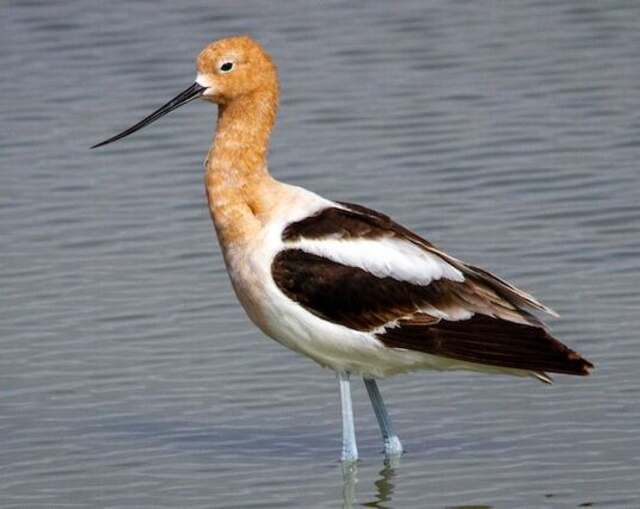
The avocet, known for its distinctive long, thin, and upwardly curved beak, has a unique adaptation for feeding on small aquatic organisms. The beak is flat and broad at the base, tapering to a fine point, which allows the avocet to probe into the mud or shallow water for food.
The sensitive tips of the beak can detect tiny prey items like crustaceans, mollusks, and insects, which are then scooped up in the flattened portion of the beak. The avocet’s beak also plays an important role in thermoregulation, as it is richly supplied with blood vessels that help regulate body temperature.
In addition, during the breeding season, the male avocet uses its beak in courtship displays, engaging in “bill fencing” with rivals or passing food to the female. Overall, the avocet’s flat beak is a highly specialized tool for foraging and has evolved through natural selection to meet the specific needs of this unique bird species.
White Ibis
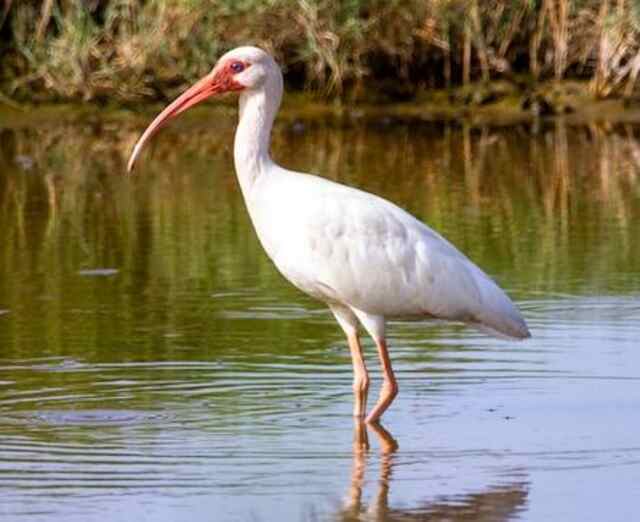
The White Ibis is a wading bird that is native to the wetlands of the southeastern United States. It has a unique flat beak that is perfectly adapted for its diet and habitat. The beak is long and curved, with a flat, wide tip that allows the bird to probe deep into the mud and water to catch its prey. The white ibis primarily feeds on small fish, crustaceans, and insects.
The flat beak of the white ibis is an essential adaptation for its survival in the wetlands. The bird’s beak is used to sense and locate prey in murky water, as well as to sift through mud and debris to find food. The flat tip of the beak acts as a shovel, allowing the bird to scoop up food from the water or mud. Additionally, the white ibis’ beak is flexible and can bend in any direction, allowing it to reach food in tight spaces.
The white ibis’ beak also plays a role in social behavior. During breeding season, males and females use their beaks to build nests and court one another. The beaks are also used in aggressive displays when defending territory or resources.
Black Skimmer
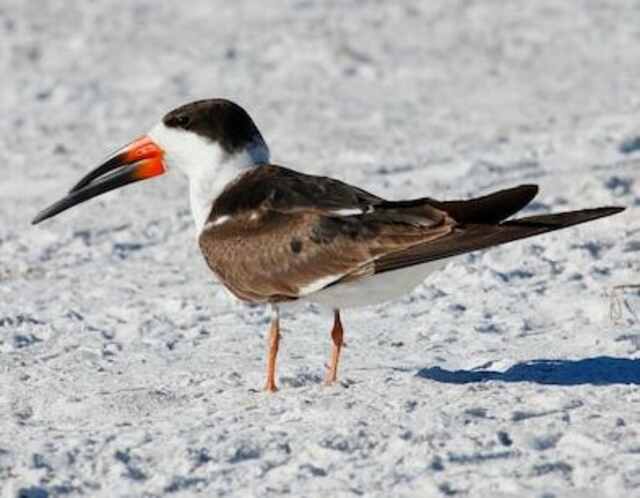
The skimmer, also known as the black skimmer, is a unique bird that is instantly recognizable for its long, thin, and flat beak. The lower part of the skimmer’s beak is longer than the upper part, creating a unique scissor-like structure that the bird uses to catch its prey. The beak of the skimmer is perfectly adapted for its feeding habits.
Skimmers are known to fly just above the surface of the water with their beaks open. They use their lower beak to skim the surface of the water, while their upper beak remains closed. When the lower beak touches a fish, the skimmer snaps its beak shut, trapping the fish inside. This technique is incredibly efficient, and skimmers can catch up to three fish per minute using this method.
Aside from being an effective tool for feeding, the skimmer’s beak also serves other purposes. The bird can use its beak to scoop up water and then tip its head back to swallow it. This behavior is particularly useful for removing excess salt from the skimmer’s body, as the bird primarily feeds on saltwater fish.
American Oystercatcher
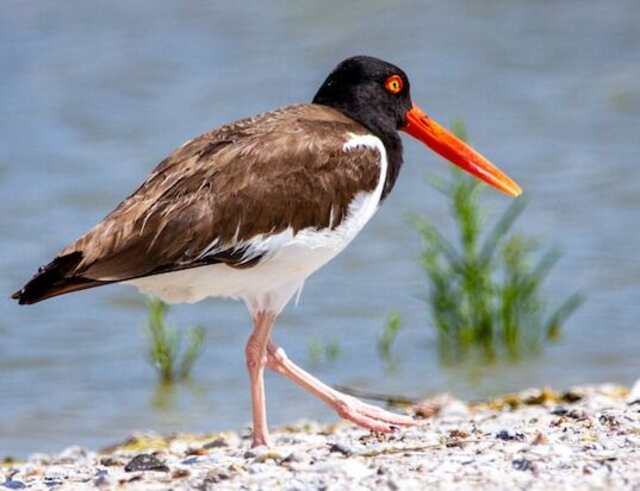
The American Oystercatcher is a stunning shorebird that is known for its unique flat beak, which is specially adapted for its feeding habits. This beak is quite distinctive, with a long, straight, and pointed shape, which is flat on the top and bottom, and slightly curved at the tip. The beak is also quite sturdy and can be up to 8cm long, making it ideal for digging into the sand and mud to find its prey.
The American Oystercatcher uses its beak primarily for feeding on mollusks, crustaceans, and other small invertebrates that live in the intertidal zone. The beak is sharp enough to pry open the shells of clams and mussels, and is also capable of breaking the shells into smaller pieces to get at the tasty meat inside. In addition to its use in feeding, the beak is also used for defense against predators and in territorial disputes with other birds.
The American Oystercatcher’s beak is an example of how evolution has produced highly specialized adaptations for specific ecological niches. This bird’s flat beak is perfectly adapted to its feeding habits and is an essential tool for its survival. Without it, the American Oystercatcher would be unable to compete with other shorebirds for food and would be at risk of starvation.
In addition to its unique beak, the American Oystercatcher is also known for its distinctive calls, which are used for communication with other birds and in courtship displays.
Pelican
Pelicans are among the most recognizable birds with their distinctive long, flat beaks. The pelican’s beak is one of the most remarkable features of this bird, and it is specially adapted to aid in catching prey. The bill is elongated and has a flattened shape that ends in a hook at the tip. It is also equipped with a large throat pouch, which can hold up to three gallons of water.
The pelican’s flat beak is primarily used for catching and consuming fish. When hunting, pelicans plunge their bills into the water and scoop up fish along with large volumes of water. They then use their beaks to strain out the water, leaving behind the fish, which they swallow whole. The large throat pouch can also be used to store food, allowing the pelican to transport fish to other locations.
The pelican’s beak is also used in thermoregulation. Blood vessels in the bill can expand and contract, allowing the bird to dissipate heat or conserve warmth as needed. In addition, the beak is used in social displays, such as when males offer food to females during courtship.
The pelican’s beak has evolved over time to become a specialized tool for feeding and survival. Its unique shape and size allow the bird to efficiently capture and consume fish, while also providing other benefits such as thermoregulation and social communication.
FAQs about Birds with Flat Beaks
What do birds with flat beaks eat?
Birds with flat beaks have a varied diet that depends on the species. Some of them eat fish, while others eat insects, small mammals, or plants. For example, pelicans primarily eat fish, while spoonbills feed on crustaceans, insects, and small fish. The type of food a bird eats determines the shape and size of its beak.
Which birds have long, flat beaks?
Several birds have long, flat beaks, including spoonbills, shoebills, and American oystercatchers. These birds use their long, flat beaks to catch prey in shallow water or mudflats.
What do birds with long, flat, serrated beaks feed on?
Birds with long, flat, serrated beaks typically feed on small fish, crustaceans, or insects. For example, the roseate spoonbill uses its serrated beak to catch small fish and shrimp in shallow water.
Which bird has a broad and flat beak?
The white ibis is a bird with a broad and flat beak. These birds use their beaks to probe into the mud and shallow water for crustaceans and other small aquatic animals.
Do ducks have flat beaks?
Ducks do not have flat beaks. They have broad, flat bills that are adapted for their omnivorous diet, which includes plants, insects, and small aquatic animals.
What kind of bird has a long, flat beak?
Several birds have long, flat beaks, including spoonbills, shoebills, and American oystercatchers. These birds use their long, flat beaks to catch prey in shallow water or mudflats.
What are the 4 types of beaks?
The four types of beaks are conical, hooked, chisel, and probing. Conical beaks are short and round and are adapted for cracking seeds and nuts. Hooked beaks are curved and sharp and are adapted for tearing meat. Chisel beaks are pointed and sharp and are adapted for chipping into wood. Probing beaks are long and thin and are adapted for probing into the ground or water for food.
What animal has a flat beak?
Several animals have flat beaks, including platypuses, pelicans, and flamingos.
Which bird has a flat beak?
Several birds have flat beaks, including pelicans, ibises, and terns.
Which bird has a broad and flat beak?
The white ibis is a bird with a broad and flat beak. These birds use their beaks to probe into the mud and shallow water for crustaceans and other small aquatic animals.
What is the pink bird with a long, flat beak?
The pink bird with a long, flat beak is the roseate spoonbill. These birds live in wetlands and use their long, flat beaks to catch small fish, crustaceans, and insects.
Conclusion
In conclusion, birds with flat beaks exhibit a remarkable adaptation to their environments, allowing them to thrive in their habitats. From the Spoonbill’s long, spoon-shaped beak to the Pelican’s expandable pouch, each bird utilizes their beak in unique ways to gather food and survive. These birds serve as a testament to the incredible diversity and ingenuity of the avian world.
Related Post: 21 Birds with Big Beaks: See Nature’s Swiss Army Knife!


